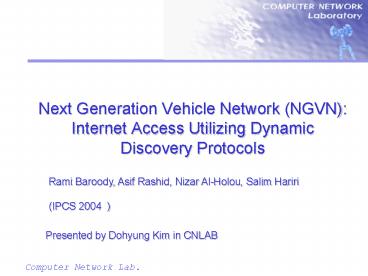Next Generation Vehicle Network NGVN: Internet Access Utilizing Dynamic Discovery Protocols - PowerPoint PPT Presentation
1 / 17
Title:
Next Generation Vehicle Network NGVN: Internet Access Utilizing Dynamic Discovery Protocols
Description:
Next Generation Vehicle Network (NGVN): Internet Access Utilizing Dynamic Discovery Protocols ... Dynamically downloaded device driver ... – PowerPoint PPT presentation
Number of Views:380
Avg rating:3.0/5.0
Title: Next Generation Vehicle Network NGVN: Internet Access Utilizing Dynamic Discovery Protocols
1
Next Generation Vehicle Network (NGVN) Internet
Access Utilizing Dynamic Discovery Protocols
Rami Baroody, Asif Rashid, Nizar Al-Holou, Salim
Hariri (IPCS 2004 )
Presented by Dohyung Kim in CNLAB
2
Contents
- Introduction
- Related work
- Dynamic Discovery Service for NGVN
- Two functional components
- Service architecture
- Service architecture components
- Evaluation
- Conclusion
3
Introduction
- Future vehicular ad hoc network
- Location based information
- Roadside installed IG (Internet Gateway)
- Node for sensing, routing, and terminal
- Issues
- Communication efficiency
- Mobility support
- Handover of connections
- Discovery of Internet Gateway
4
Related work (finding service in ad hoc network)
- Multicast (Anycast)
- Multicast group with all IGs within virtual
communication range - High implementation complexity
- Specific support for the routing protocol
- Group maintenance overhead
- Router discovery process
- MIPMANET implementation scheme
- Periodical flooding of router advertisement
message - Not scalable, impractical
5
Related work (contd)
- Service discovery protocol
- SLP (Service Location Protocol), UPnP (Universal
Plug and Play), Jini, Salutation - SLP
- JINI
- JVM on the device
- Object code can be stored in lookup server
(Directory Agent)
Predefined multicast
6
Dynamic Discovery Service for NGVN
- Based on JINI
- Two functional components
- The discovery of available IGs
- The selection of the most suitable IG
7
Discovery of available IGs
- Periodic service announcement, located in IGs
- Passive discovery
- Multicast
- Service information handling, located in vehicle
- Extract the service information from multicast
message - Store it in local database
- Discovery of the service ? Local database search
8
Selection of the most suitable IG
- Selection process based on
- Applications requirement
- Interactivity, streaming, and real-time
- The state of the vehicle network
- Current traffic density
- IGs periodical service advertisements
- of clients using the current IG
- Utilization of the IGs available bandwidth
- IGs location for estimation of the connection
duration and communication delay
9
NGVN Dynamic Discovery Service Architecture
Entertainment
Communication
On-Line Monitoring
NGVN CAR1
NGVN CAR2
NGVN CAR3
template
template
template
Access Network
INTERNET
Video on demand proxy
Entertainment
Attribute
Access Control Manager
Security proxy
On-line Monitoring
Attribute
Service Manager
Lookup Service
Smart phones proxy
Attribute
Communication
10
NGVN Services (provider side)
Service Provider
Video on demand proxy
Discovery
Entertainment
Lookup Service
Attribute
Security proxy
Lookup Service
Service Manager
On-line Monitoring
Attribute
Lookup Service
Smart phones proxy
Communication
Attribute
11
NGVN Services (client side)
Video on demand proxy
Attribute
Lookup Service
Security proxy
Client Side
Attribute
template
Smart phones proxy
Access Control Manager
Attribute
12
Components of the Architecture
- Network service proxy
- Provide all the code needed to connect to network
services - Dynamically downloaded device driver
- Hide implementation detail and communicate over
the network with service backend portion - Network service attribute
- Java object attached to service proxies
- Attribute change should be reflected to the
lookup server - Service manager
- Detect attribute changes
- Update information in all the lookup service
- Provide dynamic service property during the
lookup process
13
Components of the Architecture (contd)
- Lookup service
- Tracking of all other NGVN services
- Multicast announcement protocol
- To announce their existence
- Service templates
- Java object for clients to construct their search
criteria - Associated with service attributes
- Multicast request protocol
- Discover the lookup service
- Access control manager
- Maintain and update the list of NGVNs
- Authorization
14
Evaluation (methodology)
- SLP vs. DDS protocol
- Mathematical analysis
- Performance metric
- bandwidth usage (which is strongly related to the
coverage) - Worst case scenario
15
Evaluation
- Evaluation parameter
- Number of Vehicles (nCars) 600
- Number of Internet Gateways (nIG) 3
- Frequency of IG Request (fIGReq) 2/s
- Frequency of IG advertisement (fIGAdv) 1/s
- Duration Time (T) 1s
- Request Message Size (bReqSz) 1000 bits
- Reply Message Size (bRepSz) 1000 bits
- Advertisement Message Size (bAdvSz) 1000 bits
- Number of Hops (nHops) 2
- Number of Links (nLinks) 50
16
Evaluation (contd)
- Bandwidth usage using SLP
- (nCarsfIGReqTnIG(bReqSzbReqSz))(nLinksnHops
) - 18000 megabits for the whole network
- 18000/600 30 megabits/sec each car
- Bandwidth usage using NGVN DDS
- (nCarsfIGadvTnIG(bAdvSz))(nLinksnHops)
- 4500 megabits
- 7.5 megabits/sec each car
17
Conclusion
- NGVN DDS can be possible solutions for the
realization of IG discovery process - DDS is superior to the classical SLP in
scalability - Automatic selection of the most suitable IG

